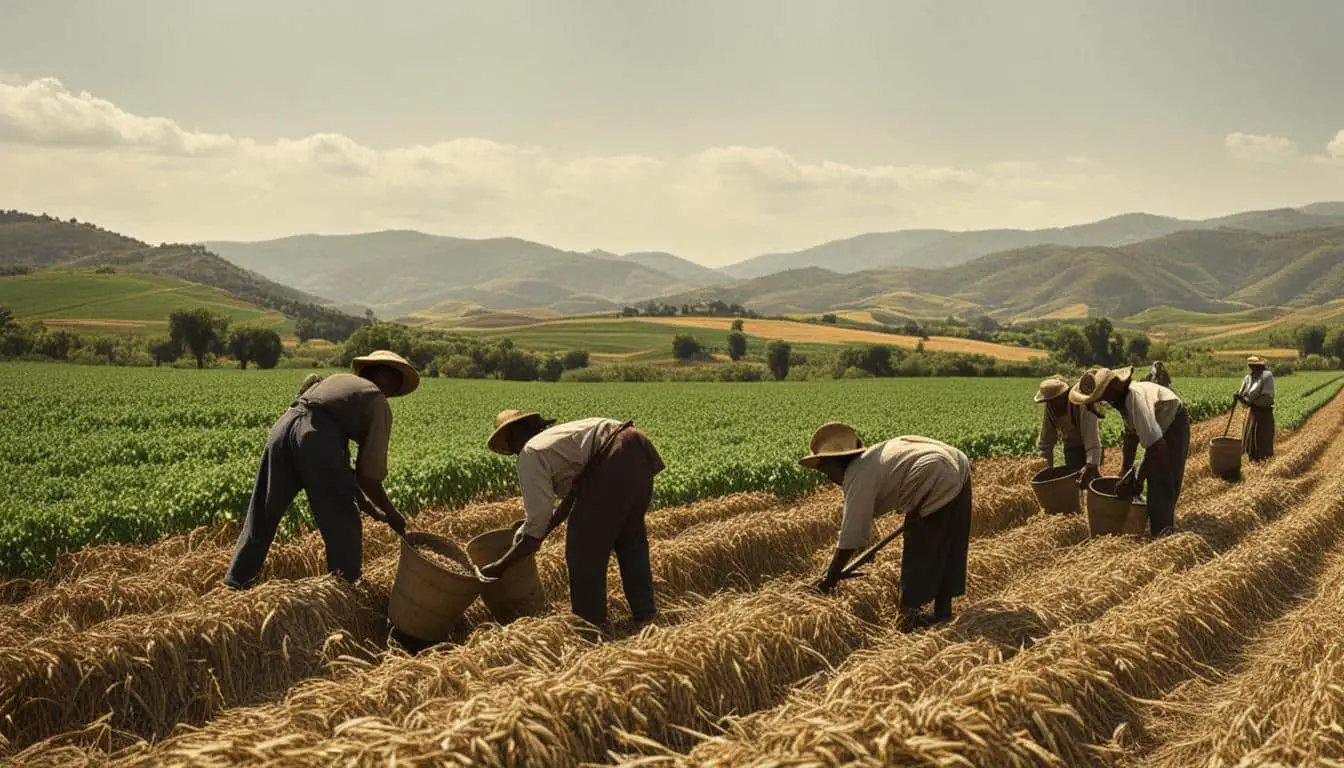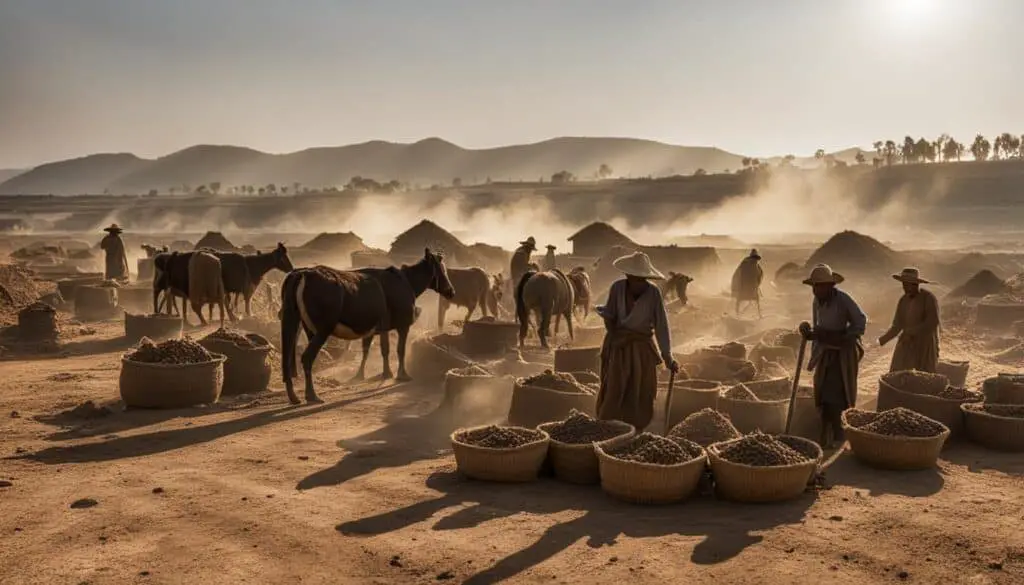
Agricultural Practices During Biblical Times: An Overview
The study of agricultural practices during Biblical times provides us with valuable insights into the ancient farming techniques and methods employed by the people of that era. In recent decades, extensive research has been conducted on the history of ancient agriculture in the Land of Israel, resulting in a greater understanding of rural settlements, agricultural technology, and the cultivation of various crops and fruit trees.
Archaeological findings, such as plant and wood remains, have shed light on agrarian practices and dietary patterns. Furthermore, the analysis of phytoliths and palynological studies has contributed to our understanding of how humans shaped the landscape and environment through their agricultural activities.
Key Takeaways:
- Agricultural practices during Biblical times have been extensively studied in recent decades.
- Archaeological findings provide insights into the technology and variety of crops cultivated.
- Phytoliths and palynological studies help understand the impact of humans on the environment.
- Agriculture played a vital role in shaping ancient societies and cultures.
- The use of tools and irrigation systems enabled successful farming.
Ancient Agricultural Practices in Pre-History
During pre-historic times, ancient agricultural practices played a crucial role in sustaining human settlements and shaping early civilizations. The study of artifacts and archaeological evidence provides valuable insights into the farming techniques employed by our ancestors. From the Mesolithic period onwards, evidence suggests that the cultivation of cereals, such as wheat and barley, was already underway.
Flint sickles, mortars, and pestles have been discovered, indicating the use of tools for harvesting and processing crops. These early farmers relied on their knowledge of the land and the seasons, utilizing rudimentary agricultural implements to cultivate the land and secure their livelihoods.
“The cultivation of cereals and the use of tools for harvesting and processing crops were integral to the ancient agricultural practices of pre-historic societies.”
As settled communities emerged during the Neolithic Age, agricultural practices became more sophisticated. Alongside cereals, other crops like rice, lentils, olives, dates, grapes, and pomegranates were cultivated. The cultivation of these varied crops not only provided sustenance but also contributed to the diversity of the diet of pre-historic societies.
| Crop | Period |
|---|---|
| Cereals | Mesolithic Period |
| Rice, Lentils, Olives, Dates, Grapes, Pomegranates | Neolithic Age |
These early agricultural practices laid the foundation for the civilizations that followed, enabling the development of more advanced farming techniques as societies grew and expanded. The cultivation of crops became increasingly essential in sustaining larger populations and supporting the growth of ancient settlements.

Ancient Agricultural Practices: A Glimpse into the Past
Exploring the ancient agricultural practices of pre-historic societies allows us to appreciate the ingenuity and resourcefulness of our ancestors. These early farming methods formed the building blocks of agricultural development and set the stage for the advancements that would shape civilizations to come.
Agricultural Practices from the Bronze Age to the Conquest of Joshua
The Bronze Age marked a significant period of agricultural development in Palestine as evidenced by historical records and archaeological findings. The biblical accounts and artifacts paint a picture of a thriving agricultural society during this time. From the accounts of the Egyptian officer Weni, we learn about the cutting down of figs and vines during military expeditions, indicating the presence of cultivated crops in the region.
The settlements along the King’s Highway and in the Judean mountains indicate a densely settled agricultural landscape, where farming played a vital role in sustaining communities. The Habiru, believed to be the Hebrew tribes of the patriarchal era, occupied marginal grasslands and practiced occasional crop cultivation.
During this period, agricultural practices were influenced by external forces as well. The expeditions of Thutmose brought plants from Palestine, showcasing the agricultural abundance and diversity of the region. This exchange of agricultural knowledge and resources enriched the farming techniques and crop varieties available to the ancient inhabitants of Palestine.
| Agricultural Practices | Key Features |
|---|---|
| Use of Irrigation Systems | Implementing irrigation systems such as canals, wells, and cisterns to ensure water supply for crops. |
| Terrace-Wall Farming | Constructing terraced fields supported by stone walls to water retention and prevent soil erosion. |
| Crop Rotation | Rotating crops to maintain soil fertility and prevent the depletion of nutrients. |
| Plowing and Sowing | Using plows and sowing seeds to cultivate a variety of crops including wheat, barley, and legumes. |
These agricultural practices laid the foundation for the thriving civilizations and the rich agricultural traditions that would continue throughout biblical times. The in-depth understanding and implementation of farming techniques allowed for successful cultivation of staple crops such as wheat and barley, as well as the growth of fruit trees like figs, grapes, and olives.
The agricultural practices from the Bronze Age to the Conquest of Joshua shaped the cultural and religious fabric of the ancient civilizations in Palestine. These practices were not only essential for food production but also influenced the social and economic systems, as seen in the provisions for the poor and the observance of the year of rest. This period laid the groundwork for the agricultural practices that would be further refined and expanded upon in subsequent centuries, leaving a lasting legacy on the land and its people.
Conclusion
Agriculture played a vital role in the ancient societies of biblical times. From pre-history to the conquest of Joshua, the development of agricultural practices shaped the way of life, culture, and faith in these ancient civilizations.
The use of tools such as hoes, plows, and sickles, combined with the implementation of irrigation systems and terrace-walls, enabled successful farming and the cultivation of crops such as wheat, barley, legumes, figs, grapes, and olives. These crops not only sustained the people but also held great symbolic and religious significance.
The rules and practices governing agriculture were deeply ingrained in the society during this period. The year of rest, known as the Sabbath Year, ensured the land was given time to rejuvenate. Additionally, provisions were made for the poor, exemplifying the importance of community and compassion within the agricultural society.
Overall, the study of biblical farming practices and ancient agricultural practices provides a fascinating glimpse into the lives and civilizations of the past. Understanding how these ancient societies sustained themselves through farming helps us appreciate the ingenuity, resourcefulness, and resilience of our ancestors.
FAQ
What is the significance of studying the history of ancient agriculture in the Land of Israel?
The study of the history of ancient agriculture in the Land of Israel provides insights into the development of rural settlements, agricultural technology, and dietary patterns. It also contributes to understanding landscape changes and the impact of humans on their environment.
When did agriculture in Palestine date back to?
Archaeological evidence suggests that agriculture in Palestine dates back to the Mesolithic period, with artifacts such as flint sickles, mortars, and pestles indicating the cultivation of cereals.
What crops were cultivated during the Chalcolithic period?
During the Chalcolithic period, agricultural settlements increased, and crops such as rice, wheat, barley, lentils, olive and date kernels, grape seeds, and pomegranate rinds were discovered.
Were there settled communities during the Neolithic Age?
Yes, settled communities emerged during the Neolithic Age, and agricultural implements and cleaving tools were used.
Who were the Habiru?
The Habiru, possibly the Hebrew tribes of the patriarchal era, occupied marginal grasslands and occasionally sowed crops. They highly valued the land, as indicated by biblical references and archaeological findings.
What crops were cultivated during biblical times?
Wheat, barley, legumes, figs, grapes, and olives were among the crops cultivated during biblical times.
What tools were used in ancient agricultural practices?
Tools such as hoes, plows, and sickles were used in ancient agricultural practices.
Did ancient farmers implement irrigation systems?
Yes, ancient farmers implemented irrigation systems and terrace-walls to enable successful farming.
Were there any rules and practices governing agriculture during biblical times?
Yes, there were rules and practices governing agriculture during biblical times, including the year of rest and provisions for the poor.
